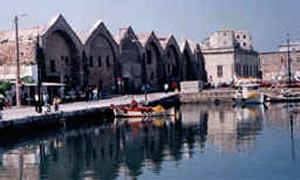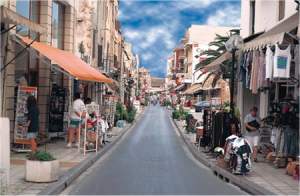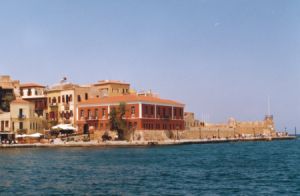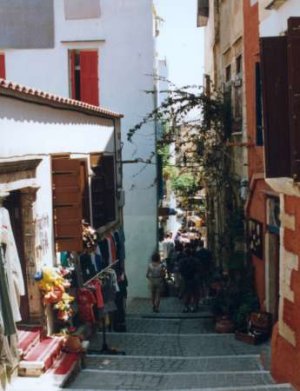|
Chania Old Town
Chania will enchant almost everyone and
richly rewards exploration with its web of side-streets, crumbling
masonry and magnificent harbour. Here are some ideas for your
walk around town:
The Inner Harbour - Lighthouse
Follow the sea wall round as far as the minaret style lighthouse
for an excellent view of the city.
 Venetian
Arsenals Venetian
Arsenals
These 16th century arched buildings designed for shipbuilding
and repairs are on to the quietest part of the harbour. There
are relics of the Minoan town on Kasteli hill as well as ruins
in Kanevaro street and Katre street.An outstanding complex
has been dug up in the square of St Catherine in a joint Greek/Swedish
project.
Halidon Street
Perhaps the most commercially touristic street in Chania,
this street leads down to the harbour front. In a square on
the right you will find Chania’s cathedral
church of the Three Martyrs. It was built on the site
of a soap factory, whose owner, the Mustapha Nily Pasha, when
he became prime Minister of the Ottoman Empire, donated the
soap factory and money to construct a church for the Christians
of Chania.  A
little further down the road a Turkish hamam survives. Across
from the cathedral is the catholic church in whose courtyard
is the entrance to the Cretan Folk Museum. Right next door
is the renovated church of St Francis, the most impressive
Venetian church on Crete, consisting of a temple and two closed
courtyards, and probably dates back to the 14th Century. Nowadays
it houses Chania’s archaeological museum, well worth a visit
to see the ceramics, inscribed tablets, glassware and mosaics
recovered from local excavation work. A
little further down the road a Turkish hamam survives. Across
from the cathedral is the catholic church in whose courtyard
is the entrance to the Cretan Folk Museum. Right next door
is the renovated church of St Francis, the most impressive
Venetian church on Crete, consisting of a temple and two closed
courtyards, and probably dates back to the 14th Century. Nowadays
it houses Chania’s archaeological museum, well worth a visit
to see the ceramics, inscribed tablets, glassware and mosaics
recovered from local excavation work.
Stivanadika (leather
street)
Just off the top of Halidon street this road is popular with
the visitor for its huge array of leather goods and articles
of Cretan folk art. You may find some of the craftsmen at
work fashioning items such as leather sandals or the traditional
Cretan boots.
Outer Harbour - Firkas
At the far end of the harbour is the Firkas fort which today
houses the Naval Museum.  The
Firkas was a fortress residence and barracks in the times
of Venetian occupation and later when the Turks invaded barracks
and prison. On 1st December 1913 the Greek flag was raised
there in celebration of the reunification of Crete with Greece. The
Firkas was a fortress residence and barracks in the times
of Venetian occupation and later when the Turks invaded barracks
and prison. On 1st December 1913 the Greek flag was raised
there in celebration of the reunification of Crete with Greece.
Theotokopoulou Street
An attractive street leading down to the harbour where you’ll
find Venetian mansions with strong oriental configurations
from the times of Turkish occupation in addition to Neo-classical
buildings. Look for the wooden balconies and latticed windows.
This area has been called Tophanas since Turkish times when
guns were stored in the area. It was a prosperous part of
town and had been a neighbourhood of the Christian aristocrats.
 At
the bottom, just before you reach the harbour you’ll see the
temple of San Salvadore. This was formerly a monastery for
Franciscan monks and now holds a collection of Byzantine art. At
the bottom, just before you reach the harbour you’ll see the
temple of San Salvadore. This was formerly a monastery for
Franciscan monks and now holds a collection of Byzantine art.
Zambeliou Street and Environs
A picturesque narrow street hosting examples of superb Venetian
architecture. It twists and climbs parallel to the harbour
with tiny lanes and steps taking you off into the past. One
such alleyway leads to the Renier mansion and elegant gateway
dated 1608. Inside is the private chapel of Renier. On the
corner of Zambeliou/Portou is a Turkish hamam, now a taverna.
Behind Zambeliou street is the former Jewish area. The Venetians
forced them to live in one confined area. The central road
is Kondilaki with its houses
of famous Jews and former synagogue.
|
